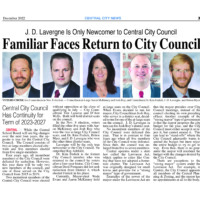
Familiar Faces Return to City Council
While the Central School Board will see big changes over the next four years, the opposite is true for the Central City Council. The Council consists of two at-large members elected citywide and five members elected from five single-members.
Four years ago, all incumbent members of the City Council were defeated for reelection. However, this year there will be only two new members of the council, and one of those served on the City Council from 2015 to 2019.
Two incumbent members of the Central City Council were elected without opposition at the close of qualifying in July — City Councilmen Tim Lazaroe and D’Ann Wells. Both will hold district seats on the council.
In the Nov. 8 election, voters filled the other five seats with Aaron McKinney and Josh Roy who won the two at-large City Council seats, and Dr. Kim Fralick, Briton Myer, and J. D. Lavergne who won the other three district seats.
Lavergne will be the only true newcomer to the City Council. He outpolled Ray Ashford.
Dr. Kim Fralick is the former City Council member who was returned to the council by voters after a four-year hiatus. City Councilman Dave Freneaux did not seek reelection from District 4, which elected Fralick in his place.
Currently, Mayor-elect Wade Evans and Aaron McKinney hold at-large seats on the City Council. When Evans decided to run for mayor, City Councilman Josh Roy, who serves in a district seat, decided to run for one of the at-large seats on the council. J. D. Lavergne in turn ran for Josh Roy’s district seat.
No incumbent members of the City Council were defeated this year. That is in contrast to four years ago when all five members of the City Council were defeated. Since then, the council was enlarged from five to seven members.
Central operates under a state law called the Lawrason Act, which applies to cities like Central that have not adopted a home-rule charter. The Lawrason Act was originally designed for small towns and provides for a “strong mayor” type of government.
Examples of the power of the mayor under the Lawrason Act are that the mayor presides over City Council meetings, instead of the council electing its own presiding officer. Another example of the “strong mayor” type of government is that the mayor proposes the city budget for the year, and the City Council must either accept it or reject it, but cannot amend it. This can lead to “stand-offs” where the City Council adamantly wants to amend the budget but must reject the entire budget to try to get its way. Even then, there is no guarantee the mayor will resubmit the budget with the changes desired by the City Council.
There are exceptions to the “strong mayor” system under the Lawrason Act. For example, in Central, the City Council appoints all members of the Central Planning & Zoning, and the mayor has no appointments at all to the body.


 November 23, 2022
November 23, 2022 







No comments yet... Be the first to leave a reply!